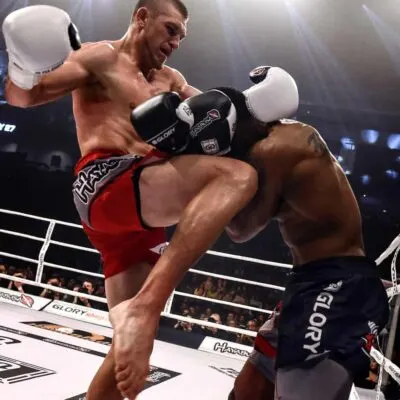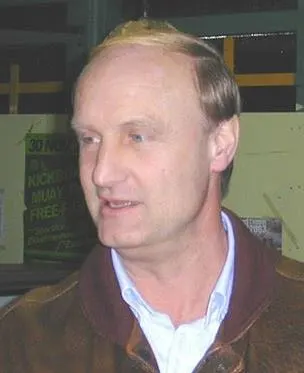
Kickboxing has been around since the 1950s and is spread worldwide. However, one particular country that most people least expect is widely recognized as the Mecca of kickboxing, and that is the Netherlands. But how? Why is kickboxing so popular in the Netherlands, where it’s not known to be culturally rooted in martial arts?
Netherlands was the first country to adopt modern kickboxing from Japan. It quickly established global dominance and became home to the best training facilities, coaches, and world champions, all of whom played very influential roles in making it a very popular sport in the Netherlands.
That was a quick overview of why kickboxing is very popular in the Netherlands. But don’t stop here – keep reading to discover more about the Dutch kickboxing style, its rich history, and the legendary fighters who played significant roles in making it popular.
What Is the History of Dutch Kickboxing?
To understand how kickboxing became a major sport and popular in the Netherlands, it’s crucial to first understand the birth of kickboxing in Japan. I’ll explain this in two parts so it’s easier for you to understand.
Part 1: How kickboxing first started
The story of Dutch kickboxing actually began in Japan. Although similar styles like Muay Thai have been around for centuries, the term kickboxing and the sport itself emerged in the 1950s in Japan. This combat sport was developed as a mix of karate, boxing, and Thai boxing techniques. Kicks and knees came from Kyokushin and Muay Thai, while footwork and punches are from Western boxing.
During the 1950s, there was a big rivalry between Kyokushin karate and Muay Thai fighters. Fighters from both arts have fought each other for years under customized rules. So naturally, kickboxing emerged as a neutral ground where fighters from both arts could fight each other under mixed rules that do not favor either style. These events became really popular in the 1960s and were primarily held in the city of Osaka.
The man who deserves a lot of credit for establishing modern kickboxing is Tatsuo Yamada. He was a skilled karateka and the founder of “Nihon Kempo Karate-do.” Crucially, Yamada was the first karateka to start training in Muay Thai. And he later started mixing techniques and rules from both styles to develop what he called “karate-boxing.”
Later on, the boxing promoter Osamu Noguchi would further upgrade this style. He named it “kickboxing,” founded the first Kickboxing Association, and organized many events.
Part 2: How kickboxing spread in the Netherlands
During the 1960s, there was a kickboxing boom across Japan, with gyms opening up in every town. One of the most famous is the original “Mejiro Gym” in Mejiro, Tokyo, and this is the place where the Dutch martial artist Jan Plas came to learn this new style.

Photo by Nanorsuaq
After a few years, Plas returned to his native Netherlands to open the European Mejiro School. And this school is considered the birthplace of the Dutch kickboxing style. Together with his friend Thom Harinck, Plas founded the Dutch Kickboxing Association in 1976. The two would produce many kickboxing world champions that would dominate the competition in the following decades.
RECOMMENDED READING: What Is ISKA Kickboxing?
Why Is Kickboxing So Popular In the Netherlands?
Back in the 1970s, the Netherlands was the first European country to adopt kickboxing, thanks to Jan Plas, who brought it from Japan. As a result, the Dutch were the ones who developed and popularized the sport from scratch.
As kickboxing gained popularity in other nations, it led to a surge in global competition, such as in K-1 kickboxing. Dutch gyms and coaches emerged as dominant winning forces in these competitions, consistently staying at the top and proving their superiority.
With Dutch kickboxers dominating the world kickboxing stage, Dutch society began recognizing their athletes as cultural heroes and embracing them as role models, which made kickboxing extremely popular in the Netherlands, to the point where it became an unofficial national sport.
As a result, almost every town in the Netherlands has at least one kickboxing school, which is full of talented up-and-coming young fighters and established fighters. And there are also large gyms where people from other countries can come and train under the best coaches.
Aspiring kickboxers from around the world often visit the Netherlands to train with skilled coaches and fighters and improve their skills. This is because the Dutch have a reputation for being excellent at kickboxing. Kickboxing in the Netherlands is similar to the popularity of wrestling in Dagestan. In other words, kickboxing is a big part of the Netherlands’ sports history, culture, and lifestyle, just like how Taekwondo is a popular sport deeply rooted in Korean culture.
On a side note, kickboxing is not the most popular sport in the Netherlands. This title belongs to soccer, which is generally the most popular sport in Europe by a large margin.
What Is the Dutch Style of Kickboxing?
The Dutch style of kickboxing emerged at the famous Meijiro Gym in Amsterdam. It is rooted in three different styles mixed into one: Kyokushin karate, boxing, and Muay Thai. The emphasis is on boxing combos mixed with fast footwork, kicks, forward pressure, and aggressiveness. Dutch-style fighters compete at a high pace, have a high output of strikes, and never throw one shot at a time.
You can easily spot a fighter trained in the Dutch style by watching kickboxing fights. They rely on their hands and hitting their opponents with advanced boxing combos. They also utilize footwork and head movement to angle out to evade the attack and out-position the opponent to create an opening for a counterattack. As soon as they see an opening, they blast their opponent with hard low/high kicks from all angles and ranges.
When you see a fighter throwing 5–6 fast punches and finishing the combo with a kick, that’s Dutch style.
They are masters at using advanced boxing combos to set up the kicks and knock their opponent out or overwhelm them with a high level of technique. They sometimes use Thai boxing techniques such as front kicks to keep their range and land body shots or jumping knees when the opponent is backed against the ropes. Some of the masters of this specific type of attack were K-1 legends Remy Bonjasky and Andy Souwer.
Training is also different than in other kickboxing styles, as Dutch gyms put a lot of emphasis on hard sparring and drills. Some Dutch kickboxing schools have quite a bad reputation when it comes to injuries and gym fights.
But according to their philosophy, intense sparring is the best way to mentally and physically prepare for combat. Strength and conditioning workouts are also brutal, as you need top cardio to maintain such a high output of strikes and pace.
Dutch kickboxing rules
Dutch kickboxing style is primarily designed to be in line with K-1 and Japanese kickboxing rule sets. Following is a detailed explanation of the key rules.
Legal strikes/Illegal — fighters can strike with kicks, punches, and knees above and below the waist. They can use leg kicks, body kicks, and head kicks, as well as punches to the head and body and knees. The use of elbows is not allowed, and there is limited clinch work.
Sweeps are allowed but won’t bring you any points or give you an advantage on the scorecards, so fighters rarely use them. Takedowns or striking the grounded opponent are strictly forbidden.
Match duration — matches can have between 3 and 5 rounds, depending on the importance of the match. Each round is 3 minutes long, and there is one minute of rest between each round. If a match ends in a draw, there is one extra round to determine the winner.
Gear — Dutch kickboxers compete wearing full-padded boxing gloves, hand wraps, mouthguards, and groin guards. They wear kickboxing shorts or leggings, as Andy Souwer did throughout his career.
Is K-1 kickboxing the same as Dutch kickboxing?
No, K-1 is not the same as Dutch Kickboxing, and here is a detailed explanation.
K-1 is a kickboxing promotion developed in Japan in 1993. The founder of this organization was Kazuyoshi Ishii, a master of Seidokaikan karate.
K-1 combines elements of various striking martial arts such as Muay Thai, boxing, karate, and kung fu. It emerged as a platform where strikers from different arts could fight against each other. And, of course, determine which striking style is the best.
On the other hand, Dutch Kickboxing is a specific style that emerged in the Netherlands. It is known for its emphasis on boxing techniques, high output and pace, pressure, and kicks and knees. Right from the opening bell, Dutch fighters would step on the gas and put pressure on their opponent without taking a step back.
Dutch kickboxers all have great cardio, which enables them to maintain a high output of strikes throughout the fight consistently, and it is really hard to keep up with them. It is a very technical style widely regarded as one of the best styles of kickboxing.
In summary, while K-1 is a sports organization, Dutch kickboxing is a specific fighting style.
RECOMMENDED READING: What Is American Kickboxing?
Who Are the Best Dutch Kickboxers of All Time?
Dozens of kickboxing world champions have come out of the Netherlands, with each one leaving a significant mark on the sport. Following is a list of the five most popular ones.
Rob Kaman — is one of the pioneers of Dutch kickboxing and a fighter who deserves a lot of credit for popularizing the sport. He is a 9-time kickboxing world champion known for exceptional technique and vicious low-kicks. The fans called him “Mr. Low-Kick” because he used this specific move to finish many of his matches. He would destroy the movement of his opponents with perfectly placed leg kicks before putting them out with punches or more kicks.
Peter Aerts — is a Dutch kickboxing legend who became famous while fighting under the K-1 banner. In the 90s, he won the K-1 World Grand Prix title three times during the promotion’s glory days, earning him the nickname “Mr. K-1”. In his career, he won 108 kickboxing matches, 81 by knockout, which gives you an insight into his brutal style.
Semmy Schilt — is among the most accomplished Dutch martial artists and physically the most intimidating one. But despite being a tall and big fighter, Schilt was very agile and an exceptional technician. Between 2005 and 2010, he managed to win four K-1 World Grand Prix titles and was simply unstoppable. He also fought a lot in MMA, where he was a Pancrase open-weight champion.
Ramon Dekkers — is a Dutch kickboxing legend who became famous for fighting in Thailand. He is known as one of the few European kickboxers who beat Thai boxers in Muay Thai. Most of his opponents in Thailand had a hard time dealing with his unconventional Dutch style of Thai boxing and his prominent violent instincts, making him one of the most feared fighters of his era.
Ernesto Hoost — is widely regarded as the best Dutch kickboxer of all time. In his long career, Hoost won the prestigious K-1 World Grand Prix title four times and fought at the top of the game for 13 years. He is also known as “Mr. Perfect” simply because he was the best in every aspect of the game—an ideal mix of high fighting IQ, superior genetics, and great skills.
RELATED: Greatest Ever: Top 11 Dutch Kickboxers of All Time – Ranked
Have There Been Any Dutch Kickboxers in MMA/UFC?
Gegard Mousasi — is one of the best strikers in MMA history. He started his career in MMA in 2003. He then switched over to kickboxing in 2004 to compete in Muay Thai and K-1, where he beat the legendary Musashi. In his MMA career, he became Bellator and Dream Middleweight champion and Strikeforce light heavyweight champion. He was also a top UFC contender for many years.
Alistair Overeem — is probably the most famous Dutch kickboxer in MMA/UFC. He became famous for fighting in MMA during the 2000s but would later switch to K-1, where he won the World GP. Later, he signed with the UFC, where he competed for many years at the top of the game. In his MMA career, he won the DREAM and StrikeForce heavyweight titles.
Gokhan Saki — is a K-1 legend and a great representation of Dutch kickboxing. For years, Saki successfully competed at the highest level of K-1 and beat many great fighters, but he never won the title. He fought under the UFC banner twice and scored a performance-of-the-night finish over Henrique da Silva in 2017.
Semmy Schilt — actually started his legendary career in MMA. He fought for the Japanese “Pancrase” promotion, where he was an open-weight champion. Later, he would also compete in PRIDE FC and the UFC but failed to win any titles. After retiring from MMA, he switched to K-1, where he won 4 World GP titles.
Bas Rutten — is a Dutch MMA legend who also started his journey in kickboxing before switching to MMA. He also fought in the “Pancrase” promotion, where he was an open-weight champion. He arrived in the UFC on a 19-fight unbeaten streak and won two more fights in the UFC, winning the UFC heavyweight title, before retiring from competition.
What Are The Most Popular Kickboxing Promotions?
Kickboxing as a combat sport is not as popular as in the 1990s or 2000s; however, it is still more than relevant in combat sports. In modern times, there are a couple of promotions where Dutch style and other kickboxers compete, with GLORY and ONE FC being the most popular.
GLORY kickboxing has been around since 2012, and it is home to the best kickboxers in the world. Their roster is packed with talented Dutch kickboxers, and most of the events are hosted in the Netherlands and other parts of Europe and the US. GLORY competitions attract the very best kickboxers from around the world, but it’s the Dutch-style kickboxers who primarily dominate the competition.
ONE FC is known as the best MMA promotion in Asia. However, this organization also organizes Muay Thai, and Kickboxing matches inside the MMA cage, and these matches are incredibly exciting. Each event mixes MMA, Kickboxing, and Muay Thai fights, making the show dynamic and fun to watch. Many great kickboxers, such as Georgio Petrosyan, Nicky Holzken, Andy Souwer, and many others, have already fought for ONE.
